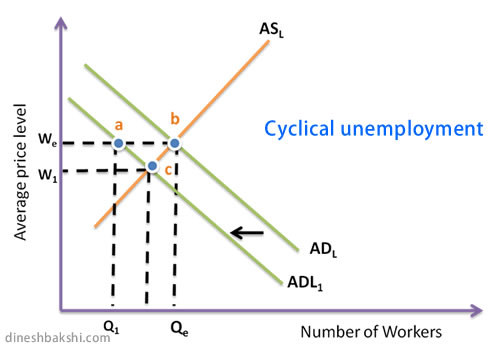Types of unemployment
Cyclical or Demand Deficient unemployment
Cyclical unemployment exists when individuals lose their jobs as a result of a fall in aggregate demand (AD). The fall in AD, in the economy, results in the fall in real output and thus unemployment. It is called also known as demand deficient or Keynesian unemployment.
Cyclical unemployment through a diagram
As we can see in the AD/AS diagram, the fall in AD to AD1 will result in a fall in the Real output (Y1).
This will force the firms to reduce their output and hence reduce their workforce from ADL to ADL1. However, due to ‘wage stickiness’ it is less likely that real wages will fall (as seen in the labour diagram). Therefore, the wages instead of coming down to W1 will remain at We. This will create a surplus situation where the aggregate demand for labour will be at ‘a’ and the aggregate supply of labour will be ‘b’.

Wage stickiness: The firms may not be able to reduce the wages may be as a result of the following reasons:
- They don’t want to create discontent among the workers by reducing their wages
- Trade unions may not allow the wages to go down.
- Labour contract may deter the firms to reduce the wages.
Structural unemployment
Structural unemployment occurs when certain industries decline because of long term changes in market conditions. These structural changes in the economy might lead to fall in demand for certain sectors of the economy. This is usually common in developing countries where primary sector generally reduces in size and secondary sector and tertiary sector might gain more importance. Change in technology is also one of the major reasons for structural unemployment, whereby certain kind of jobs become obsolete. Changes in consumer taste or preference may also be a cause of structural unemployment
Structural unemployment may worsen if there is
- Occupational immobility occurs when there are barriers to the mobility of labour between different industries and occupations.
- Geographical immobility exists when there are barriers to people moving from one area to another to find work.
Frictional Unemployment
Frictional unemployment occurs when people leave their jobs and are unemployed while they are looking for a new job, or just having a break from working.
Seasonal Unemployment
Unemployment attributable to relatively regular and predictable declines in particular industries or occupations over the course of a year, often corresponding with the climatic seasons.
Watch a Video





